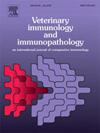Comprehensive analysis of the major IgY antibody extraction strategies from chicken egg yolk
IF 1.4
3区 农林科学
Q4 IMMUNOLOGY
引用次数: 0
Abstract
IgY technology refers to the process of producing, extracting, and utilizing IgY antibodies from the egg yolk. The extraction of IgY from the avian egg yolk is particularly interesting due to its potential as a reservoir of targeted antibodies for infection prevention. The objective of our study was to evaluate and compare the efficiency and purity of antibodies obtained through four different IgY extraction procedures: water dilution (WD), polyethylene glycol (PEG) precipitation, chloroform (CF) extraction combined with PEG extraction, and phenol (PHE) extraction. The WD and CF techniques exhibited increased protein quantities; however, the reported IgY purity was reduced due to impurities detected in the SDS-PAGE analysis. The PEG technique provided a well-balanced approach with moderate protein content and greater purity than the WD and CF approaches. The phenol extraction procedure resulted in the best level of purity for IgY; however, the yield was lower. The WD methods and PEG precipitation extraction methods offer an effective and practical approach to purifying IgY antibodies. It is suitable for efficiently producing high-quality IgY on a wide scale following purification. The functionality of the IgY molecule is unaffected by various extraction techniques throughout an ELISA demonstration. This comparative study aims to gather valuable observational data on various IgY extraction methods. The main aim is to optimize these approaches to effectively address the specific demands of different practical working situations and antibody applications.
鸡卵黄中IgY抗体主要提取策略的综合分析
IgY技术是指从蛋黄中生产、提取和利用IgY抗体的过程。从禽类蛋黄中提取卵黄IgY特别有趣,因为它有可能成为预防感染的靶向抗体储存库。我们的研究目的是评估和比较通过四种不同的IgY提取方法获得的抗体的效率和纯度:水稀释(WD)、聚乙二醇(PEG)沉淀、氯仿(CF)提取联合PEG提取和苯酚(PHE)提取。WD和CF技术的蛋白质含量增加;然而,由于SDS-PAGE分析中检测到杂质,报道的IgY纯度降低。PEG技术提供了一种平衡良好的方法,蛋白质含量适中,纯度高于WD和CF方法。苯酚提取工艺得到的IgY纯度最高;然而,收益率较低。WD法和PEG沉淀萃取法为纯化IgY抗体提供了一种有效而实用的方法。适用于纯化后大规模高效生产高质量卵磷脂。IgY分子的功能在整个ELISA演示过程中不受各种提取技术的影响。本比较研究旨在收集各种卵磷脂提取方法的有价值的观测数据。主要目的是优化这些方法,以有效地满足不同实际工作情况和抗体应用的具体需求。
本文章由计算机程序翻译,如有差异,请以英文原文为准。
求助全文
约1分钟内获得全文
求助全文
来源期刊
CiteScore
3.40
自引率
5.60%
发文量
79
审稿时长
70 days
期刊介绍:
The journal reports basic, comparative and clinical immunology as they pertain to the animal species designated here: livestock, poultry, and fish species that are major food animals and companion animals such as cats, dogs, horses and camels, and wildlife species that act as reservoirs for food, companion or human infectious diseases, or as models for human disease.
Rodent models of infectious diseases that are of importance in the animal species indicated above,when the disease requires a level of containment that is not readily available for larger animal experimentation (ABSL3), will be considered. Papers on rabbits, lizards, guinea pigs, badgers, armadillos, elephants, antelope, and buffalo will be reviewed if the research advances our fundamental understanding of immunology, or if they act as a reservoir of infectious disease for the primary animal species designated above, or for humans. Manuscripts employing other species will be reviewed if justified as fitting into the categories above.
The following topics are appropriate: biology of cells and mechanisms of the immune system, immunochemistry, immunodeficiencies, immunodiagnosis, immunogenetics, immunopathology, immunology of infectious disease and tumors, immunoprophylaxis including vaccine development and delivery, immunological aspects of pregnancy including passive immunity, autoimmuity, neuroimmunology, and transplanatation immunology. Manuscripts that describe new genes and development of tools such as monoclonal antibodies are also of interest when part of a larger biological study. Studies employing extracts or constituents (plant extracts, feed additives or microbiome) must be sufficiently defined to be reproduced in other laboratories and also provide evidence for possible mechanisms and not simply show an effect on the immune system.

 求助内容:
求助内容: 应助结果提醒方式:
应助结果提醒方式:


